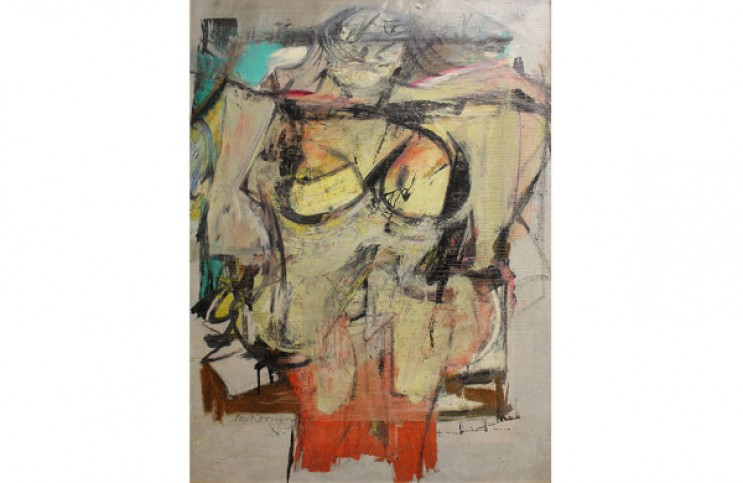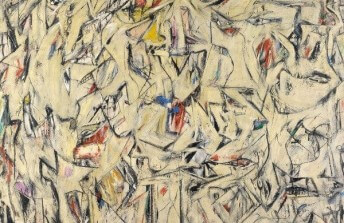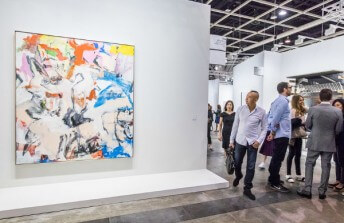The Movie-Like Story of Willem de Kooning's Woman-Ochre painting
Mar 22, 2019
Next month, restoration will begin on one of the most notorious paintings of the 20th Century: “Woman-Ochre” (1955), by Willem de Kooning. The painting is part of the famous Woman series, in which de Kooning depicted highly abstracted images of the female form on tortured, painterly, almost collage-like surfaces. “Woman-Ochre” was painted the same year that de Kooning painted “Interchange,” also known as the second most expensive painting of all time (after “Salvator Mundi” by Leonardo da Vinci). Two other paintings from the Woman series—“Woman III” (1953) and “Woman as landscape” (1955)—are also on the list of the top 100 most expensive paintings of all time. But its potential market value is not the only reason “Woman-Ochre” is notorious. Its notoriety comes courtesy of two unknown art thieves. The painting was originally purchased two years after its completion by a Baltimore architect named Edward Joseph Gallagher Jr. He lived in New York, but vacationed in Arizona. After reading a story about the older masterpieces in the collection of the University of Arizona Art Museum, Gallagher decided to donate 200 Modern works to the museum from his personal collection. “Woman-Ochre” was included in his donation, along with works by such luminaries as Mark Rothko and Jackson Pollock. The donation stipulated that none of the donated works could ever be sold by the museum. However, that did not stop “Woman-Ochre” from disappearing. On the day after Thanksgiving, 1985, the painting was cut from its frame and stolen right off the wall of the museum. Although a museum security guard got a good look at the suspected thieves, he was not able to catch them, and despite his description to the police, they were never apprehended.
The Recovery
“Woman-Ochre” remained at large until 2017, when it re-appeared in a New Mexico antique store. The story of its re-emergence begins with a quiet, middle class couple named Jerry and Rita Alter. The Alters lived their golden years in a modest ranch home in Silver City, New Mexico. Jerry, a retired musician and public school teacher, died in 2012. Rita, a speech pathologist, passed away in 2017. Their estate was bequeathed to their nephew, who liquidated the contents of the house, in part through an estate sale. One of the buyers in attendance at the sale was David Van Auker, the owner of Manzanita Ridge Furniture and Antiques in Silver City.
While looking over the contents of the house, Van Auker noticed what he would later describe to The Washington Post as “a great, cool midcentury painting.” He purchased the painting, took it back to his shop and put it on display. One at a time, customers started pointing out how much the painting looked like a Willem de Kooning. Van Auker dismissed the comments at first, until he came across a story of the theft of “Woman-Ochre.” Then he realized he may have broken the case wide open. Van Auker phoned the University of Arizona Art Museum and told them he might have their missing de Kooning. They sent experts to the shop to investigate, and sure enough the painting perfectly fit the description of the missing work.
The Likely Thieves
Suspicions, of course, immediately went to Jerry and Rita Alter. From family photos there is now no doubt that the stolen painting was hanging in their bedroom for more than 30 years. But few who knew them thought it possible that this mild-mannered couple were actually art thieves. Family members suggested that they must have unwittingly bought the painting from the thieves, not knowing where it came from. And this could be true. The Alters were apparently sharp investors. Despite earning modest incomes, they had enough money to travel to more than 140 countries together. Furthermore, they somehow managed to leave behind more than one million dollars in savings after they died.
But the Alters also kept meticulous diaries of their travels, and took many personal photographs. The more the police looked into their diaries and photos, the more likely it seemed that the Alters could, in fact, have been the thieves. For starters, their appearances resembled the police sketches originally drawn from the account given by the museum security guard. Secondly, Rita was wearing a similar coat in several of her photographs to that worn by one of the thieves. The couple also drove a similar car to that in which the thieves were spotted driving away. Most incriminating, the Alters happened to be on vacation in Tucson in 1985 during the Thanksgiving weekend. That places them close to the scene of the crime. Then again, that could also just mean they were in the vicinity at the right time to have bought the stolen painting from the actual thieves.
The Restoration
Since no fingerprints were found at the scene of the crime, and the museum had no security cameras at the time, it is unlikely the Alters will ever be proven guilty nor innocent. The one thing we do know, however, is that “Woman-Ochre” is in terrible condition. Not only was it sliced out of its frame, but its exhibition in the Alter home for so many years thoroughly contaminated it. That is soon about to change, though. The painting is on its way to the Getty Conservation Institute at the J. Paul Getty Museum in Los Angeles. There, it will be cleaned and re-united with its original frame as well as the scraps of canvas that stayed behind with the frame after the painting was sliced away. Eventually, “Woman-Ochre” will be put on view at the Getty Museum in 2020, before being returned to its rightful home at the University of Arizona Art Museum. Hopefully, this time around the museum will heighten its security. When they first received the painting half a century ago, de Kooning was well-known, but hardly the legend he is today. The painting was worth thousands back then, not millions. Today, its worth is calculated at more than one hundred million dollars—perhaps enough to make it worth investing in a private security force to make sure history does not repeat itself.
Featured image: Willem de Kooning - Woman-Ochre, 1955. Oil on canvas. 76 cm × 100 cm (30 in × 40 in). University of Arizona Museum of Art. © 2019 The Willem de Kooning Foundation / Artists Rights Society (ARS), New York.
All images used for illustrative purposes only
By Phillip Barcio



